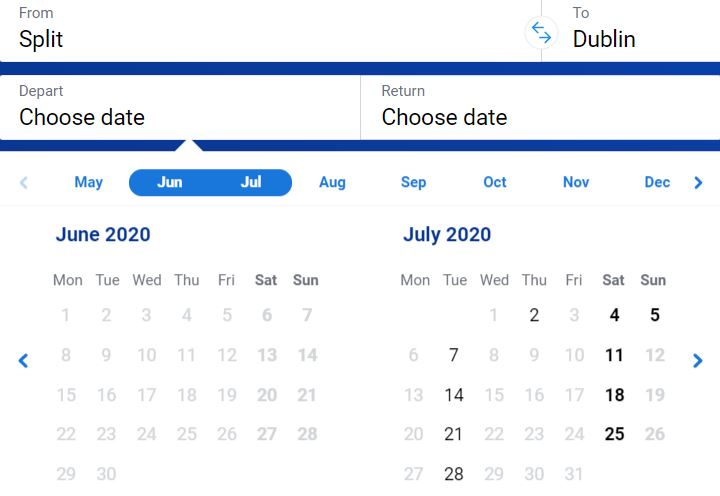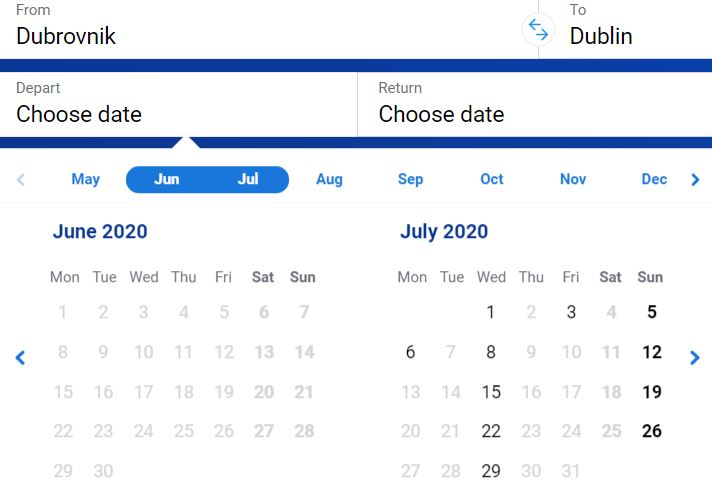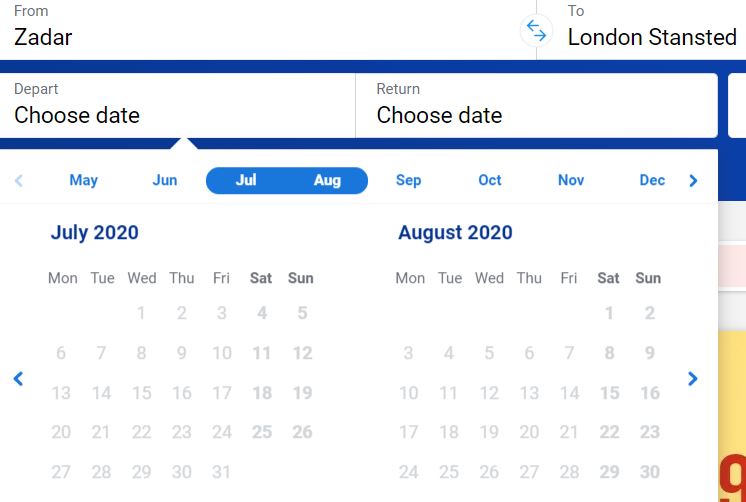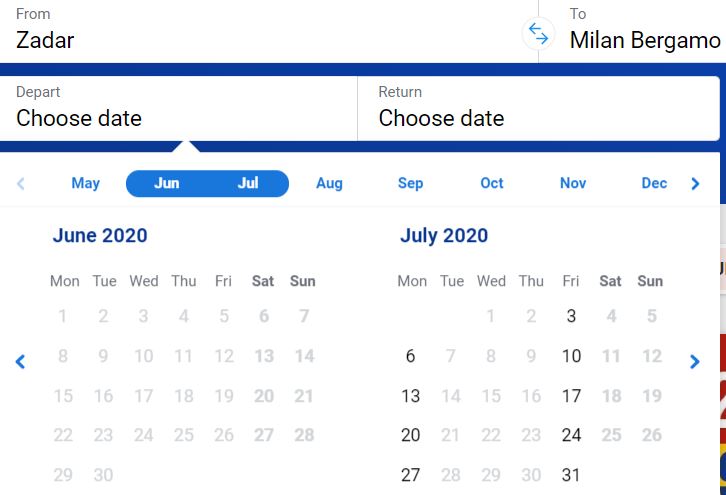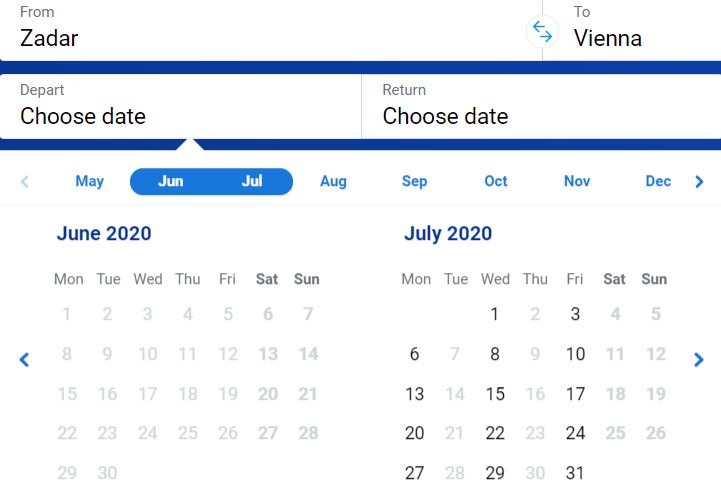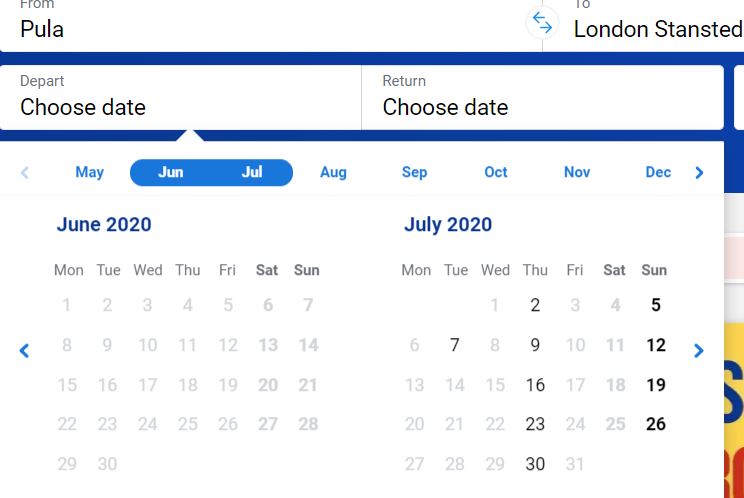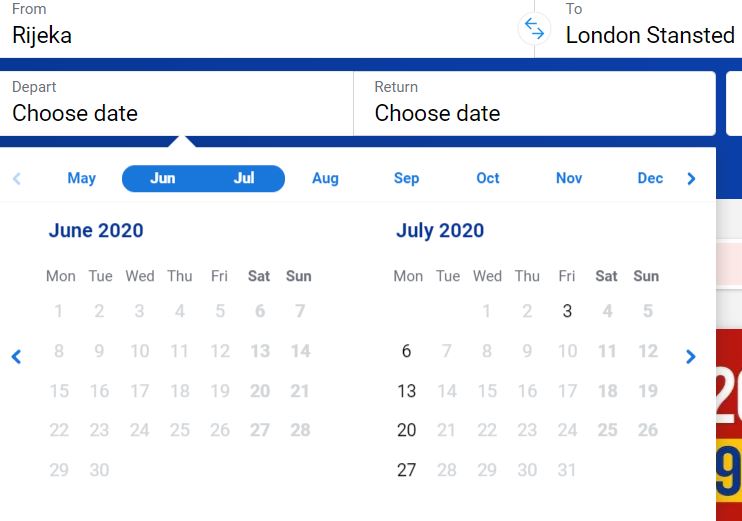Olympic Qualifying Tournament Dates Set for Split, NBA Stars to Help Croatia
May 14, 2020 - Croatia will have the help of NBA players in the qualifications for the Olympic Games next summer.
Gol.hr reports that the qualifying tournaments for national basketball teams to participate in the Olympic Games in Tokyo, which have been postponed for the summer of 2021, hosted by Split, Belgrade, Kaunas and Canadian Victoria, will be played from June 29 to July 4 next year. The news was decided after consultations between the World Basketball Federation (FIBA) and the International Olympic Committee (IOC).
At the meeting of the FIBA Executive Board in early April, changes were voted in the competition calendar, where the qualifying tournaments were scheduled from June 22 to July 4, with the representatives of the umbrella basketball organization advocating the start of the competition as late as possible, so that the national teams and players have more time to prepare.
The biggest problem for the realization of this idea was the deadline for the completion of Olympic qualifications for all sports, set by the IOC on June 29, 2021. However, the working group of the IOC Executive Board accepted the arguments put forward by FIBA representatives in talks on qualifying tournament dates and on Wednesday, it was confirmed that the date for all four tournaments would be from June 29 to July 4, according to a district letter sent to national federations on Wednesday by FIBA Secretary General Andreas Zagklis.
Recall, Croatia is one of the hosts of the tournament. Thus, in Split, the Croatia national team will face off against Brazil and Tunisia in the first round, and Russia, Germany and Mexico in the second group. The two best national teams will advance to the semifinals, and only the winning national team of each of the four tournaments will win a place among the 12 national teams that will play at the Olympic Games in Tokyo.
To read more about sport in Croatia, follow TCN's dedicated page.
Chops Grill is Back in Business with Special Three-Course Menu
May 13, 2020 - The wait is over... Chops Grill is back in business with a tempting three-course menu!
On Monday, May 11, the National Civil Protection Headquarters allowed Croatian caterers the right to serve their beloved followers again - and as you can imagine, the news was welcomed with open arms.
All of us who missed indulging at our favorite restaurants in Split or sipping coffees in the sun on the Riva are now fully back in action, though, of course, in a much more careful capacity.
Disinfectants are king today, but if that's what it takes to win a seat back at Chops Grill, its safe to say that we're not thinking twice.
To celebrate their return to the Split restaurant scene, Chops is back with a three-course menu that will have the locals drooling.
For starters, you can choose between a leek and potato soup, tuna carpaccio, panzanella salad with skuta cheese, or beef tartare with toast and butter.
The price of the three-course menu is depicted by the main course you choose (from 135 to 275 kuna). For the non-meat eaters in the group, try the beet risotto with skuta cheese or the seafood linguine pasta.
Those of you partial to chicken can savor in the chicken supreme with mashed potatoes, seasonal vegetables and a reduced chicken sauce.
Since Chops specializes in beef, there are a variety of options to choose from, like the beef skewers with vegetables and dried mushrooms, served with roast potatoes, or the 300-gram rump steak stuffed with cheese and pancetta, served with roast potatoes and a blue cheese sauce.
The real winners, however, are the beef wellington, dressed with mashed potatoes and truffles, and the T-bone steak, simply served with roast potatoes.
Because no meal would be complete without dessert, you can choose to end your meal with a creme brulee foam with forest fruits and vanilla, semifreddo, chocolate brownie, or traditional rožata with lavender, rose extract and cream.
What are you waiting for?
For reservations and more info, email This email address is being protected from spambots. You need JavaScript enabled to view it., visit their Facebook page, or call +385 91 365 0000. You can also visit their website here.
To read more about lifestyle in Croatia, follow TCN's dedicated page.
Ryanair to Croatia Planned for July: Zadar, Split, Dubrovnik, Rijeka, Pula Flight Info
May 12, 2020 - As CEO Michael O'Leary announces the resumption of 40% of its schedule from July 1, what does that mean for flights with Ryanair to Croatia?
It has been quite a day for flight news for Croatia so far, and it is not yet midday.
Firstly BA is now selling flights to both Split and Zagreb from June 15, as reported earlier. And then THIS.
Ryanair plans to restart 40% of its flights from July 1. You can read all the detail in the link to The Guardian above, as I have no value to add to that announcement.
But what specifically does this mean for Ryanair to Croatia? With so many people using Ryanair to Croatia, we have had more emails about this than anything else in recent weeks. Especially regarding flights to the main Ryanair destination on Croatia's Adriatic coast - Zadar.
As I don't have any inside information about Ryanair, we have to look at the online tools available, most notably the Ryanair booking engine.
Which shows us some VERY interesting things, and not such good news for the thousands of Brits and Irish tourists planning to fly Ryanair to Zadar.
The plan, it seems, is for Dublin and Split to be connected once more, with the first flight on July 2.
Same story with Dubrovnik and Dublin, starting on July 1.
But Zadar? Not a single flight to Zadar from the UK or Ireland to Zadar with Ryanair is showing.
But Ryanair has not abandoned Zadar completely, far from it. Flights from Milan are due to recommence twice a week on July 3.
Three times a week from Vienna from July 1. And the same story from various other European cities. But not from the UK and Ireland.
And the UK love with Ryanair to Croatia continues from London Stansted to Pula from July 2.
And to Rijeka from July 3.
But to Zadar, seemingly at least, nothing at all. I will see what I can find out. If anyone has any info, please contact me on This email address is being protected from spambots. You need JavaScript enabled to view it. Subject Ryanair.
You can of course search for your own flight info on the official Ryanair website.
You can keep up to date with the latest flight news in the dedicated TCN flights to Croatia section.
British Airways Will Fly to Zagreb and Split from June
May 12, 2020 - British Airways announced its flight schedule for June, which includes two destinations in Croatia - Zagreb and Split.
Croatian Aviation reports that according to the current schedule, the British airline will fly to Zagreb and Split next month in a significantly reduced flight schedule compared to their operations before the outbreak of COVID-19.
Namely, from June 1, British Airways will fly between London (Heathrow) and Zagreb three times a week (Mondays, Fridays, and Sundays) on the A320 aircraft.
The route between London (Heathrow) and Split will operate from the same date. The line will run four times a week in June (Mondays, Thursdays, Fridays, and Sundays).
Seasonal routes to Dubrovnik and Pula on British Airways are not on sale for now. It is expected that the number of weekly flights to Zagreb and Split will increase in July, and then the lines from London to Pula and Dubrovnik could start operating in a reduced form.
Croatian Aviation also touched on how air traffic to Croatia will look after the pandemic. Given that the world is still somewhat on lockdown, it is tough to predict all the details, but if the traffic at Croatian airports is 50% of that in 2019, airports will be satisfied.
Croatia began to attract large international airlines, which, in turn, managed to survive in our market. Some will return this summer, some next, and some will kick Croatia out of their network of destinations.
American Airlines canceled Dubrovnik for this year and removed all B767 aircraft from the fleet, which is the aircraft on this route. If the situation in the world stabilizes soon, this line could return to traffic as early as next summer. Last year, American introduced the route to Dubrovnik along with several other European destinations, and it was the airline's best hit among all other routes, which flew to far larger European cities. The line started operating three times per week, and another trip was added in September. The announcement for this year was great, as American was supposed to fly to Dubrovnik every day!
Air Canada Rouge has canceled the Toronto - Zagreb route for this year and will remove all 25 B767 aircraft from its fleet. The question arises as to how the long-haul Air Canada Rouge network will function in the future given that this was the only long-haul type of aircraft in the carrier’s fleet. Air Canada has announced several times so far that it does not plan to launch a route to Zagreb, but that the Rouge branch will operate it, so there are no great prospects for the arrival of this carrier. Given that demand will be lower and that the Air Canada mainline has cut a large number of routes, Rouge could use Air Canada aircraft in next summer's flight schedule, which would definitely be a plus for the travel experience.
Air Transat has delayed the Toronto-Zagreb route for July, but we can expect the complete cancellation of this line. Will this carrier return to Zagreb? Most likely. Air Transat is a leisure company, and if Air Canada Rouge does not return, Air Transat will have no competition on this route and will certainly profit.
Korean Air has also canceled the line between Seoul and Zagreb for this year. Given the financial situation of this company, if Korea does not react through state aid, the company will have to go through a major restructuring, and in that case, the line to Zagreb will not return as it has been operating since September 2018. However, the company can do what it did before 2018 - introduce regular charter flights on this line.
Qatar Airways has reduced the number of departures to Zagreb, and there is no fear that this carrier will not return to Croatia given that this line is maintained by tourists but also Croatian and Slovenian citizens, especially because Qatar Airways does not fly to Ljubljana and the choice for passengers departing from Ljubljana was slim even before the pandemic. Qatar, therefore, canceled the planned line to Dubrovnik. Given that this airline has been in negotiations with Dubrovnik Airport for years on establishing a line between Doha and Dubrovnik, its introduction is expected, if the situation stabilizes soon, next year.
Emirates has reduced Zagreb and plans to fly again on the route from Dubai in July. This carrier, which has only large capacity aircraft in its fleet (B777, A380) is currently in trouble. The small flexibility of the fleet, especially in capacity, makes it impossible to adjust market demand and it is now obvious that this airline had to have long-haul aircraft of smaller capacity in its fleet as well. Over 300 seats on the departure from Zagreb were often too many (except for the peak season). The line may be canceled entirely this year, and it would be logical for partner FlyDubai to operate on it with a significantly smaller capacity, the B737.
Thai Air Asia X has planned several rotations in the summer flight schedule between Bangkok and Zagreb. These were intended regular charter flights that will certainly not happen this year.
To read more about travel in Croatia, follow TCN's dedicated page.
Brasserie on 7 in Split is Back for Beverages and Cakes!
May 11, 2020 - Cafes in Croatia have reopened... and Brasserie on 7 is back with beverages and cake!
It's the moment many of us have been waiting for since March... 19th? Cafes and restaurants can reopen in Croatia! For the country's avid coffee drinkers, there could be no more welcoming news.
As the coronavirus measures in Croatia ease, we are given a taste of 'normal' life once again - and the return of our favorite cafes undoubtedly provides us with a sense of familiarity.
One of the biggest players in the Split coffee game is Brasserie on 7, who has reopened its Riva hotspot for beverages and cakes.
"Dear Friends,
It is with great excitement to announce that we are re-opening our doors tomorrow, the 11th of May. We look forward to reuniting with our colleagues and regular customers who have made Brasserie there home over the years!
Please note- for the first stage of opening we will only be serving beverages & our cakes!"
The early birds the group can wake up at B7 with a selection of 100% fresh fruit juices, like the simple ‘Pick Me Up’, embodying the flavors of carrot, orange, pineapple, and ginger, to the aromatic tones of apple, pear, and rockmelon in the ‘Split Sunrise’.
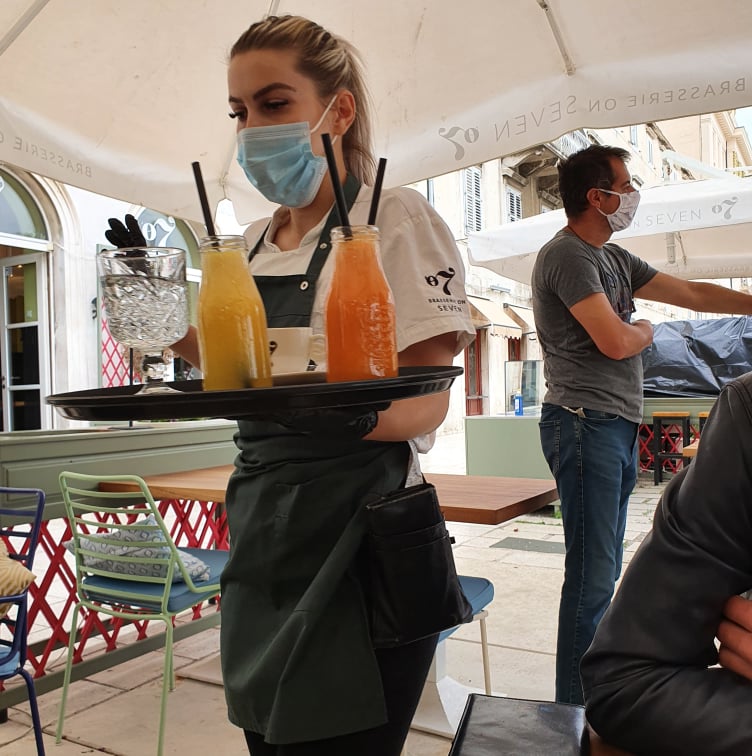
Better yet, you get to try B7’s specialty coffee by Hug & Punch Coffee Co., a new roaster in the ever-growing Croatian coffee scene, which launched back in 2018. Brasserie on 7’s very own signature blend boasts beans from Brazil, India, and Peru, with a hint of chocolate to pair perfectly with the confection of your choice.
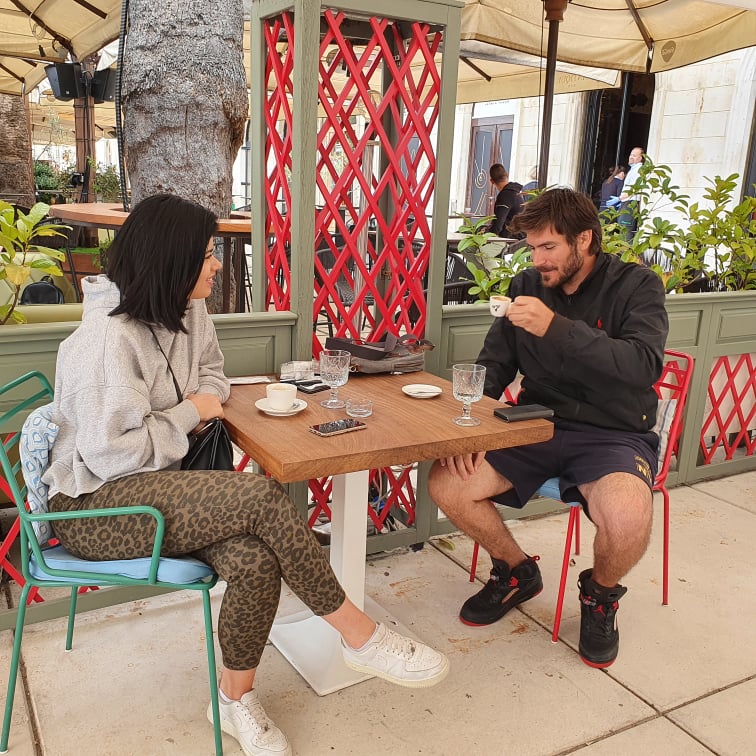
All of B7’s loyal followers know that there is no better way to begin or end the day than with one of their decadent desserts prepared in-house, now served in plastic for your safety.
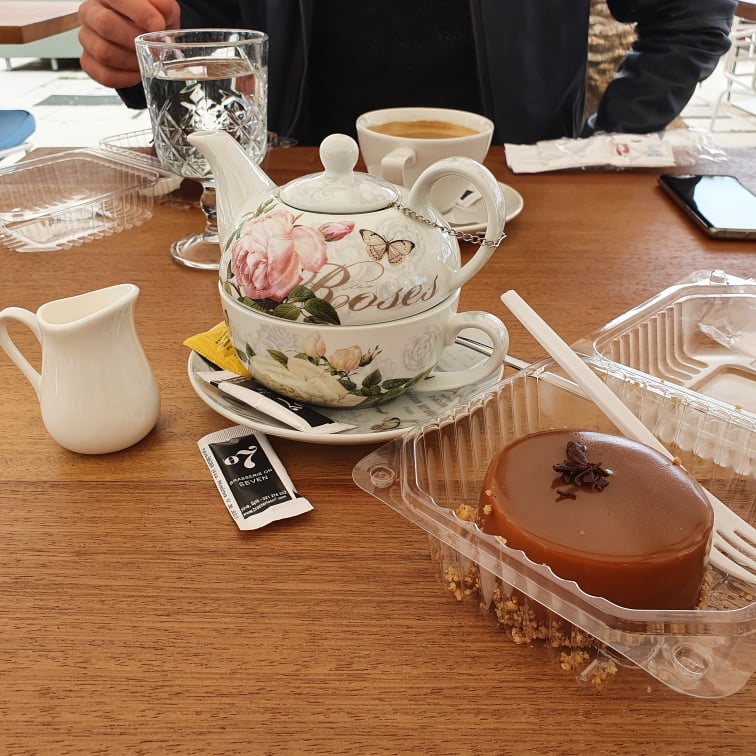
So, will you be going to B7 today?
You can learn more about Brasserie on 7 here.
To read more about lifestyle in Croatia, follow TCN's dedicated page.
PHOTOS: Exploring 3rd-Century Diocletian Aqueduct
May 10, 2020 - The Diocletian Aqueduct is an archeological site in Solin, a suburb just outside the city of Split.
Dalmacija Danas reports that this Roman aqueduct was built at the same time as Diocletian's Palace (late 3rd - early 4th century), its purpose was to bring larger amounts of drinking water from the source of the Jadro river to Diocletian's Palace, and most likely the surrounding settlements.
From the source of the Jadro river to the Palace, the aqueduct is about nine kilometers long, and visitors can explore its underground part, which is about 700 meters long and starts at the 5th kilometer.
Polish blog Crolove explored the site two years ago, and wrote that the difference in level is 33 meters and the slope is equal 3% on the entire stretch. You can find steel pins nailed into the wall of the tunnel every few tens of meters, which were used to fit a string that helped the constructors set the slope.
The Diocletian Aqueduct stopped working as early as the middle of the 6th century when it was damaged in the invasion of the Goths, after which it did not work for a full 13 centuries. It was mostly renovated during the reign of the Austro-Hungarian Empire and there is evidence that the renovation was done in earlier periods as well.
Since 1932, when the modern water station in Kopilica began working, this famous Roman aqueduct was abandoned, as new pipes for water supply to the city of Split were laid, and only the excess water flowed through the old aqueduct.
In 1948, after the typhus epidemic, the use of drinking water from aqueducts was prohibited. Since 1979, the aqueduct was completely interrupted (downstream from the intersection of today's Domovinskog rata and Puta Stinica streets).
The aqueduct is currently being restored.
Sapa Split, a local photography group, accompanied The Mladichi on an exploration of the ancient aqueduct a few days ago. You can check out their experience below.
To read more about lifestyle in Croatia, follow TCN's dedicated page.
UNESCO Heritage of Croatia: Historical Complex of Split with Palace of Diocletian
May 7, 2020 - After her extensive coverage elsewhere in Croatia, TCN UNESCO correspondent Filipa Marusic returns home for her latest installment - the Historical Complex of Split with Palace of Diocletian.
After all my UNESCO articles, I’m finally writing a piece about the heritage of my hometown Split. The article will take a look into a still standing culture with the history dating back to the 3rd century AD, which makes Split a city which is more than 1700 years old. The article will present all the heritage located in the old town in the centre of Split.
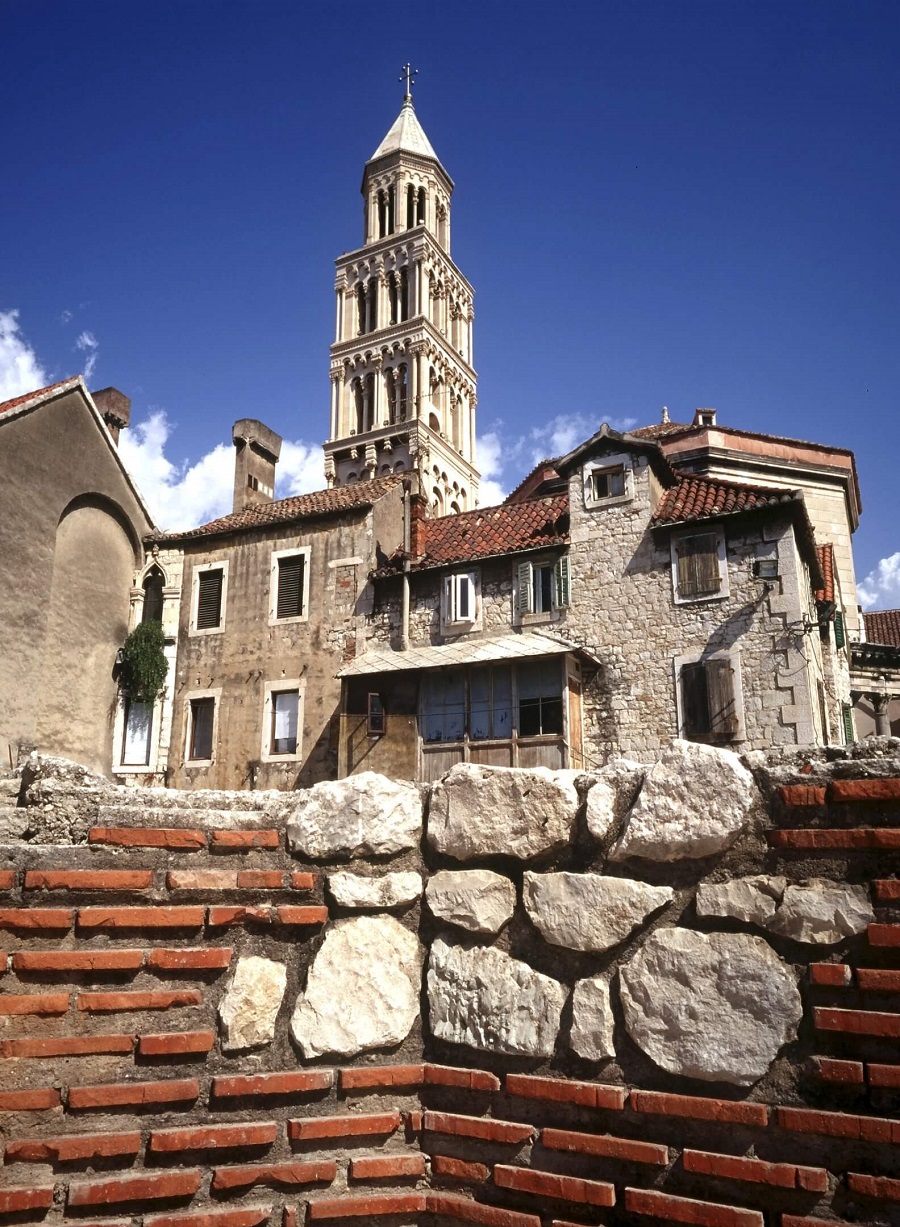
The foundation of the second-largest city in Croatia was a Roman palace built by Emperor Diocletian who decided to spend the last years of his life in Split. Now Split is a big mixture of different architectural, historical, and cultural heritage, a combination of art styles and city with traditions inherited throughout centuries. The Palace of Diocletian and the historical complex of Split have been part of the UNESCO World Heritage list since 1979. The main reason for UNESCO protection is the excellent preservation level of the Palace of Diocletian, as well as the fact that different parts of history are visible in the city structure and were used and reused in the past as well as today. The relatively small old town centre has a different heritage ranging from Roman Palace to Medieval Romanesque churches, Gothic and Renaissance palaces and portals, baroque facades, and modern-day buildings. The historical complex includes the ruins of Diocletian’s Palace built between 295 to 305 as well as Medieval buildings such as the Cathedral tower, 12th and 13th-century Romanesque churches, medieval fortifications, 15th-century Gothic palaces and other palaces in Renaissance and Baroque style. A lot of material from ancient times was reused in building newer structures in the middle ages. Diocletian’s Palace is one of the best-preserved examples of Roman architecture in the world. Along with the historical heritage, Split city centre still has locals living there, as well as tourists who visit seasonally.
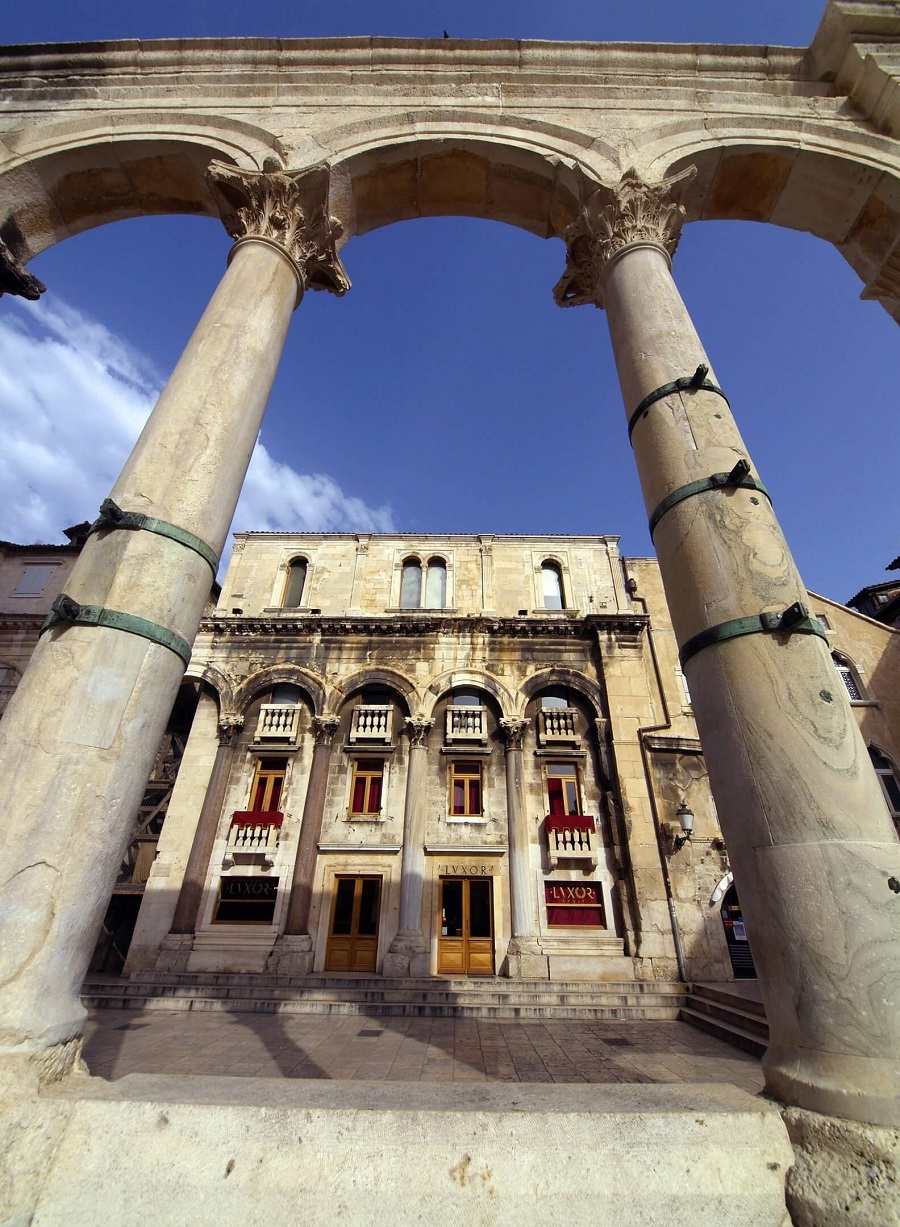
Archaeological findings show that there were even older Illyrian and Greek settlements and even some traces from prehistory before the Palace. Urbanistic development started in the 7th century, after the fall of Salona when local people moved to Diocletian’s Palace and the surrounding area. Split changed different authorities throughout the centuries. It started with Croatian kings in the 10th century, then during Medieval times Split became an autonomous commune. From 1420 to 1797 the city was under direct Venetian rule, while in the 16th and 17th centuries, this area was under attack by the Ottomans. From the end of the 18th century, Split is under Austrian rule and then short French rule during Napoleon times, and then after under the Austro-Hungarian empire where it is part till 1918. From 1918, Split was part of the Kingdom Yugoslavia (SHS). During the Second World War, it was under Italian and German occupation and became one of the centres of antifascist resistance. After the war, it became part of Socialist Yugoslavia and then from the 1991 part of the Republic of Croatia.
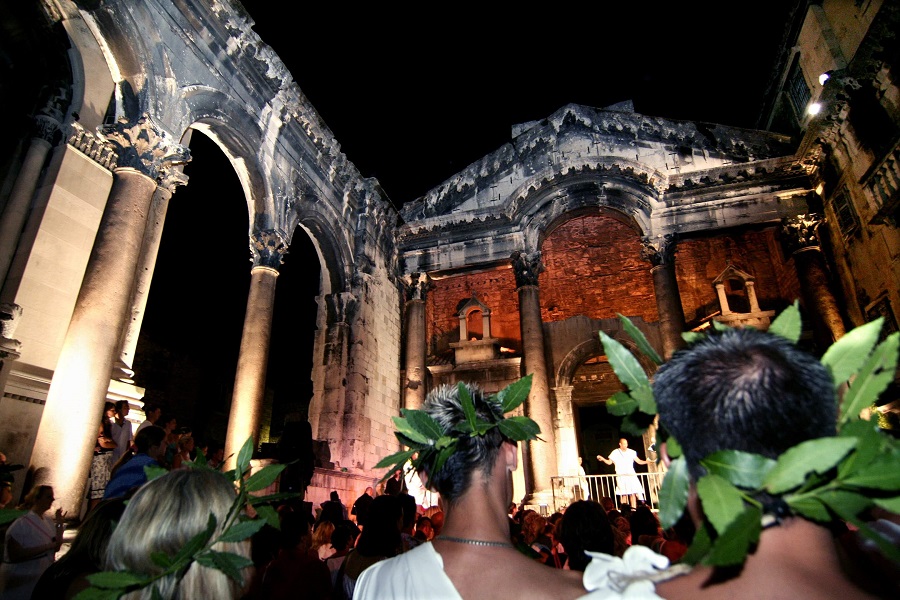
To understand Diocletian’s Palace in Split, we will take a look into the life story of Diocletian. Emperor Diocletian was born in nearby ancient Salona in 243. He became a soldier and rose to military commander and commander of the emperor’s guard. According to legend, one prophet once told Diocletian he would become emperor when he killed a wild boar. When the city perfect called Flavius Aper (aper meaning wild boar) killed emperor Numerian, Diocletian killed him and became emperor in 284. During his 20 year rule, he introduced order, secured the borders, and created a new territorial division of the empire, separated military and local municipality, reorganised the army, finances, and taxes. In 285, he introduced Maximilian as his co-emperor, and in 293, he introduced a new model of a ruling called tetrarchy. He ruled the east part of the empire and had its base in Nicomedia, while Maximillian ruled the west part of the empire – both were Augusts, and each had its substitute Caesars. There were two Caesars, Galerius and Constantius Chlorus – the idea was the Caesars inherit Augusts' place. In 303, he introduced several rules for persecuting Christians and is considered as one of the biggest persecutors of Christians. He abdicated in 305 and moved to Split, and he is remembered as the only Roman emperor who voluntarily abdicated. He did gardening as a hobby and told people of Rome, “If you only knew how good is cabbage here, you would never call me back to Rome.” There is a theory Diocletian had rheumatism, and Split was the perfect place to choose as his residential home as it has several sulphur water springs. He died in 316 and was buried in the mausoleum. The mausoleum is now in use as the Split Cathedral dedicated to St Domnius, one of the victims of its rules against Christians.
Diocletian’s Palace is a combination of a Roman military camp called Castrum, and a luxury villa. The builders were Greeks called Zotikos and Filokos, and it represents a masterpiece of late antique architecture. The Palace of Diocletian is divided into four parts and has two main streets. The size of the Palace is 180 x 215 m. The stone used for the palace building was from the quarry in Seget, from Brač and different parts of the Roman Empire, even from Egypt. Three sides of the Palace were built-in military styles with forts, high walls, and double gates, while the south side was the place for emperors’ apartment decorated with columns and arcades. The emperor’s residence had 68 rooms – the same as the number of the rooms in palace basements. The scheme of both palace levels is the same, and based on well-preserved palace basements, and one can tell what is what in the emperors’ apartment. The lobby of the flat was the Vestibule circular area, and in front of it is Peristyle – the main central place for emperors’ ceremonies and now one of the main squares in central Split. Peristyle square is surrounded by temples – to the east, there is the mausoleum now in use as a cathedral, and to the west, three temples – Cybele temple, Venus temple, and in the middle, Jupiter temple. Peristyle is the intersection of two main streets – Cardo (going south-north) and Decumanus (going east-west). Cardo street leads to Peristyle from the main entrance or North gate. Decumanus divided the Palace in the north path for the staff, military, and stables while the south part for the emperor’s family. These streets were much broader than now and were 12 m wide.
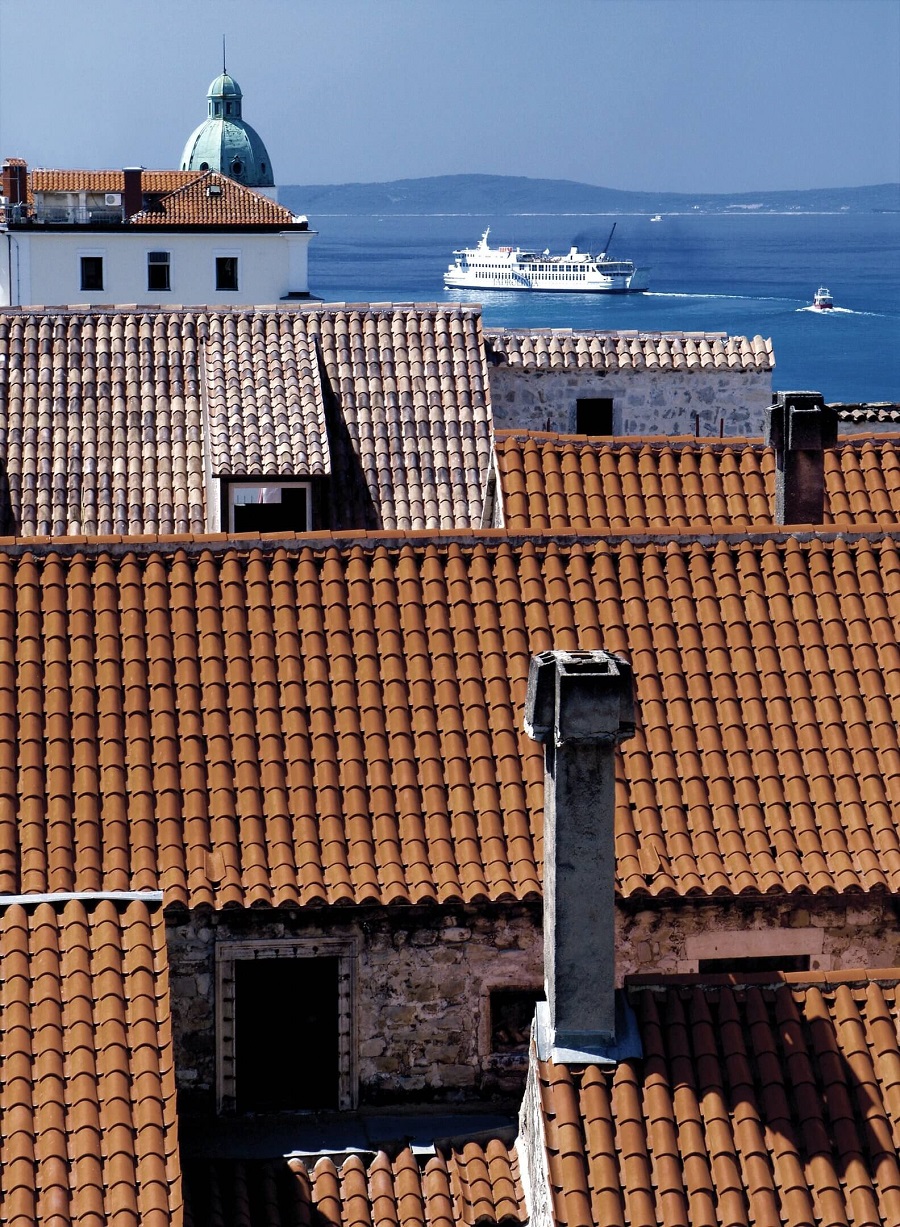
All the outer walls of the Palace are mostly the same apart from the western wall. The south part of the Palace was the only one without towers, and the other palace walls had 16 defence towers, out of which there are just three preserved. The south part of the Palace was more luxurious, and it was elevated with palace substructures to level it up with the north part of the Palace. The front walls of the Palace are large and without any defence towers, while the upper part has large open windows with arches, columns, and wreaths. The emperor’s apartment had a square shape from the outside and circular shape from the inside. The apartment has not really been preserved, but based on the setting of the lower substructure level, one could tell the layout of the rooms. On the west side, there are remains of the hall with a dome, and on the east side, there are the remains of Triclinium - the eight angle dining room with three halls in the shape of a cross. In the southwest are remains of the ancient spa while on the east next to Triclinium is Palace of Emperor's wife and daughter. In this part, there are also two churches built - church of St Andrija de Fenestris – rebuilt ancient sleeping room and St Nicola de Sdoria – rebuilt ancient west hall of the dining room. Today the Ethnographic museum is located right next to the triclinium. The apartment had a long room on the south called cryptoporticus from where there were 42 window openings and three arches with an open view to the sea. In front of the south wall, there was a dock for ships 12 metres wide. This means Split always had some promenade, which is today popularly called Riva.
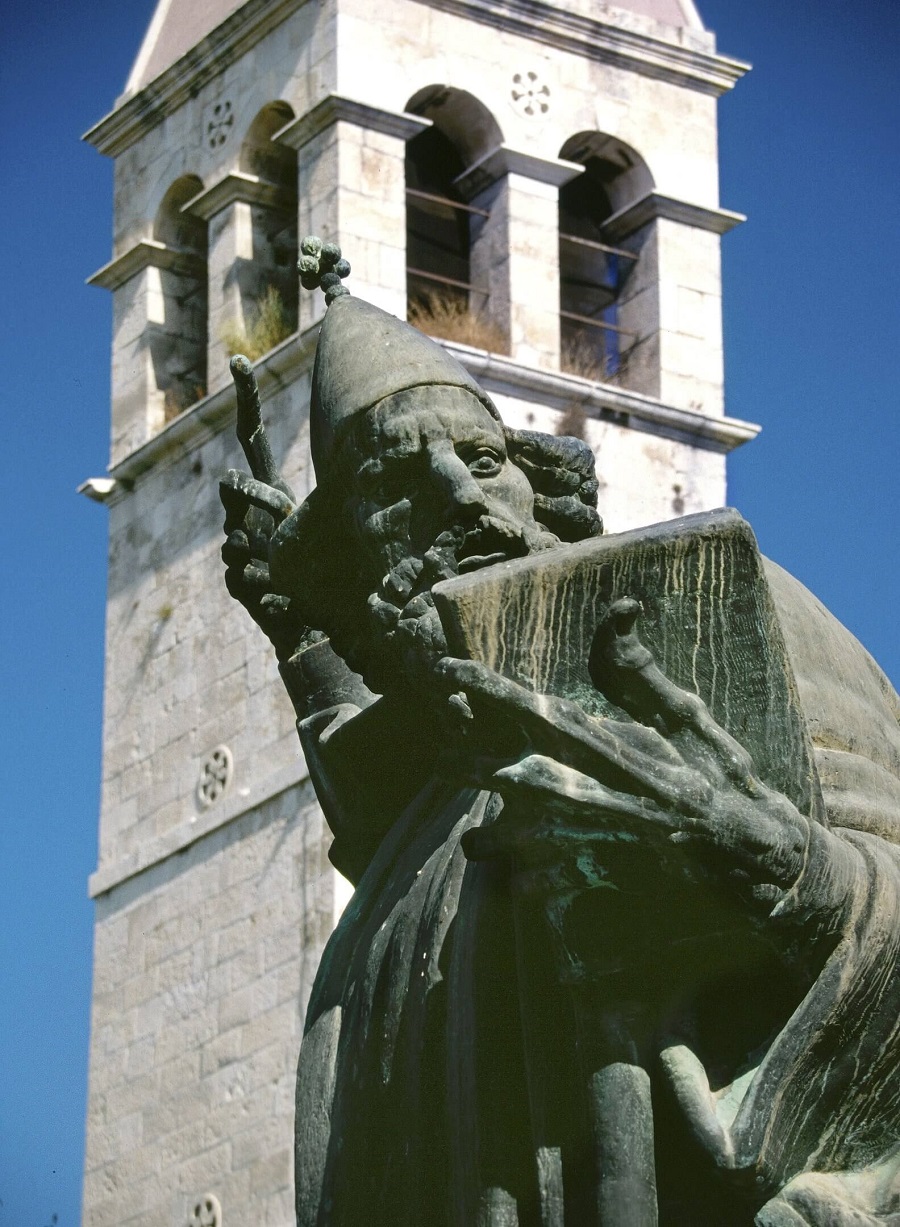
The Palace basements or substructures present a range of halls and rooms and cover one-eighth of the total palace surface. The palace substructures are one of the best-preserved parts of the Diocletian’s Palace and one of the best-preserved examples of Roman architecture from Late Antiquity. The common name for this space is basements or “podrumi.” This is the lower storage for food, oils wine and arms. The primary function was to support and elevate the upper floor where the emperor’s apartment was. Each room in the basement is the same shape as the top floor, and that’s why the palace basement was important for reconstructing the upper part of the Palace. In early Medieval times, the part of the basements was used as a residential area, and one of the halls has elements of an ancient oil and wine press. With people moving outside the basements around the palace area, the basements started to be used as first as storage and then used as junkyard and sewer. Most of the walls and arches are preserved except the wall on the east side of the substructures. These parts offered construction material even for the cathedral's bell tower. Most of the substructure walls are made by using opus quadratum, which is an ancient Roman construction technique where squared blocks of stone of the same height were set in parallel courses, often without the use of mortar. The rediscovery of the substructures started in the 19th century, and it continued in the 20th century in the 1950s. There is about 85% of the total surface rediscovered, and among other findings, there were parts older than Diocletian’s Palace itself. There are different findings, which include water wells in the western part and marble table mensa from Diocletian’s dining halls in the eastern part of the basements. The basements opened to the public in 1959 with the west part, and the east part was opened late as 1996. Today it is fully open for visits and often hosts different events and was one of the filming locations for famous worldwide Game of Thrones show. The central hall is the main passage from Riva promenade and Peristyle square and place to do souvenir shopping.
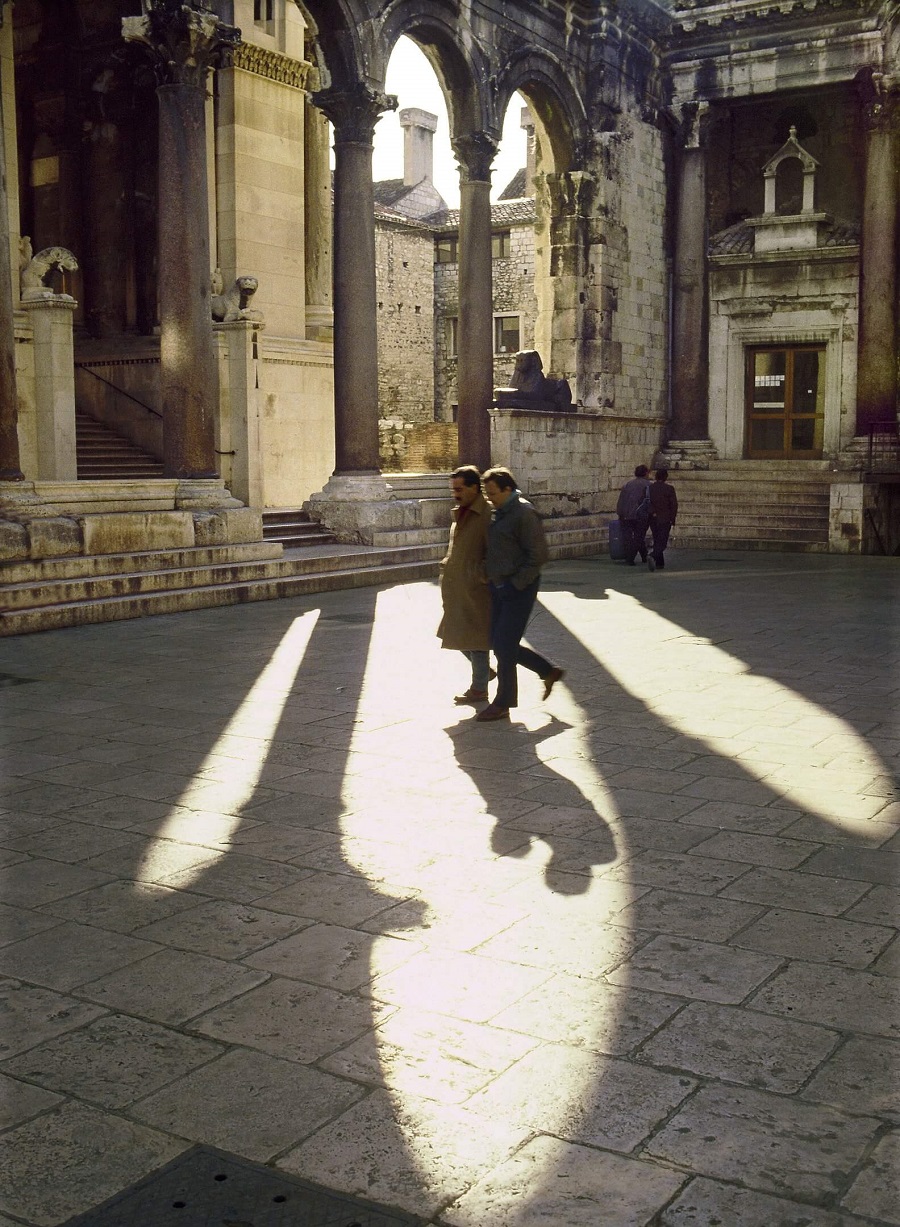
Peristyle is one of the most remarkable places in Split – this was the ceremonial and central place of the Palace decorated with columns. It was intended for Emperor Diocletian to be celebrated as the living son of Jupiter. The Peristyle space is levelled down with three steps in correlation with surrounding streets. This minimised the difference between the height of the south part of the Palace and the lower part on the north. On the south is the entrance to the emperor's apartment, and on the east is the emperor's mausoleum. On the west side, there are three temples – Cybele's temple, Venus temple, and Jupiter's temple. Jupiter's temple was dedicated to the main god of Roman mythology and the divine father of the emperors. Jupiter's temple is rectangular, and it is placed on an elevated podium with a six-column porch. As emperor abdicated, some parts of the temple weren't finished. During late antique and medieval times, the temple was turned into St John baptistery, and the crypt was consecrated to St Thomas. In the 13th century, there was the baptismal font in cross shape placed and made from altar pluteus from the Cathedral. On one of the marble board, there is the oldest image of Croatian king, probably Krešimir IV or King Zvonimir. In inside, there are two sarcophaguses with Split bishops from the 10th and 11th centuries. There is also an Ivan Meštrović statue of St John the Baptist. Barrel coffered vault influenced the early renaissance art of Dalmatia. In the 11th century, there was an early Romanesque tower, which was removed in the 19th century. In front of the temple is one of the partially preserved sphinxes. Next to the temple is the smallest street in the Palace called Let me pass street or "pusti me proć"
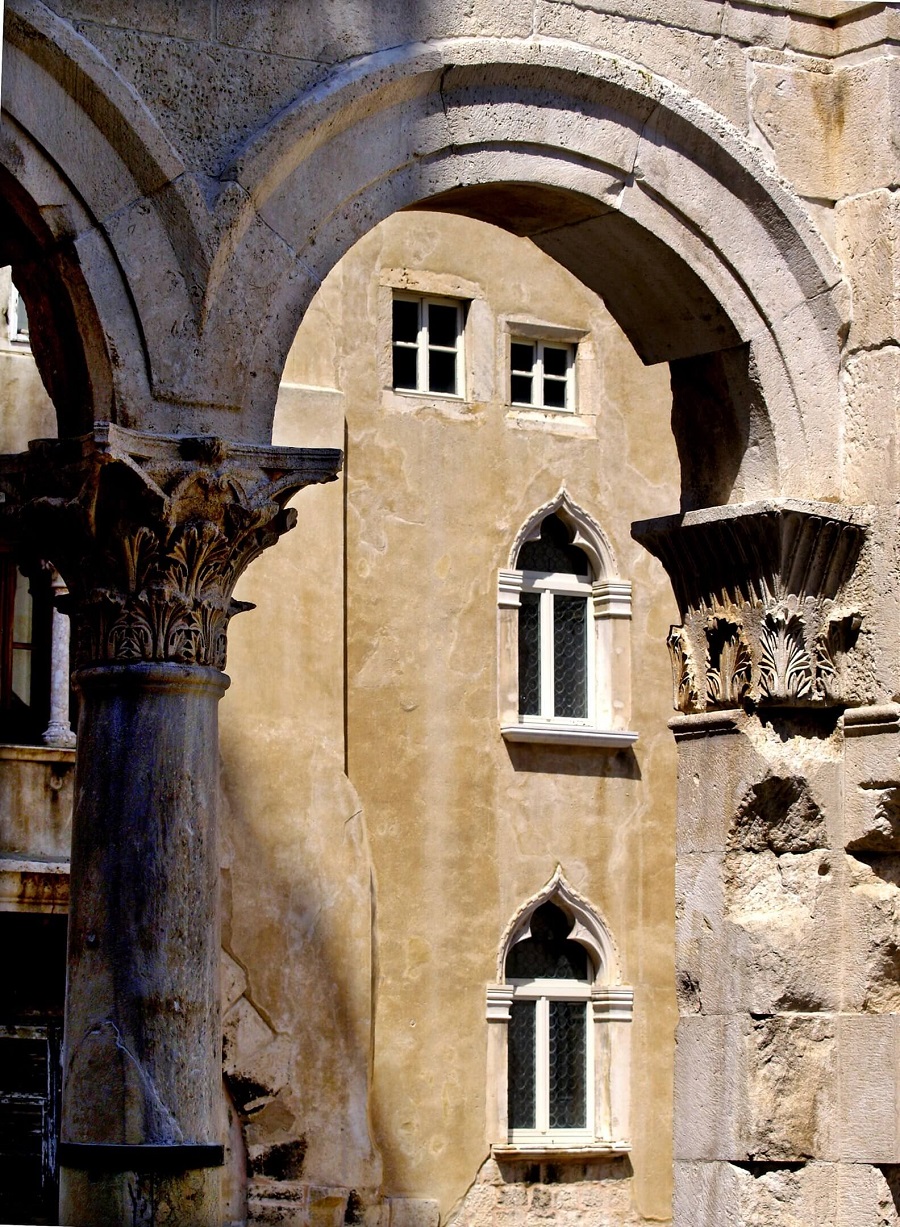
The south side of Peristyle has four columns with Corinthian capitals are the foundation for three-angle tympanums above the semi-circular arch - this monumental entrance to Diocletian's apartment is called Protiron. Between the central columns of Protiron, there is a fenced imperial lodge where Diocletian would appear on special occasions to receive honors from citizens of the Palace and other visitors. These ceremonies were connected to the cult of the emperor, where the emperor showed himself to citizens as a god, and they would probably greet him by kneeling or laying down on the pavement. On top of the Protiron, there was a monumental sculpture – possibly horses in quadriga. In the 16th and 17th centuries, Protiron got two chapels and a central baroque arch. On the east side of Protiron, there is the chapel of Our Lady of Conception from the 16th century, and on the west side of Protiron, there is the chapel of Our Lady of Health or Our Lady of Pojas built as a token of gratitude for rescue from the plague. Left and right from Protiron, there is colonel of six Corinthian columns made of marble and porphyry, which were brought from Egypt. These columns are decorated with wreaths between the arches. The red color of the porphyry columns symbolised the ceremonial function. The entrance to the mausoleum is in between the columns, opposite of the entrance to the Jupiter's temple. In the east part of Peristyle, there is a renaissance church of St Roko, which one of the churches built as church consecrated to saints protects from the plague. In Dalmatia, St Roko and St Sebastian were especial worshiped. People of Split built the church in the 16th century, and it became storage during the renovation of the tower. Today is the location for the info centre of the Split tourist board. And on the west side, there are late-medieval buildings and places Skočibušuć, Cipci (first Split city hall), and Grisogono.
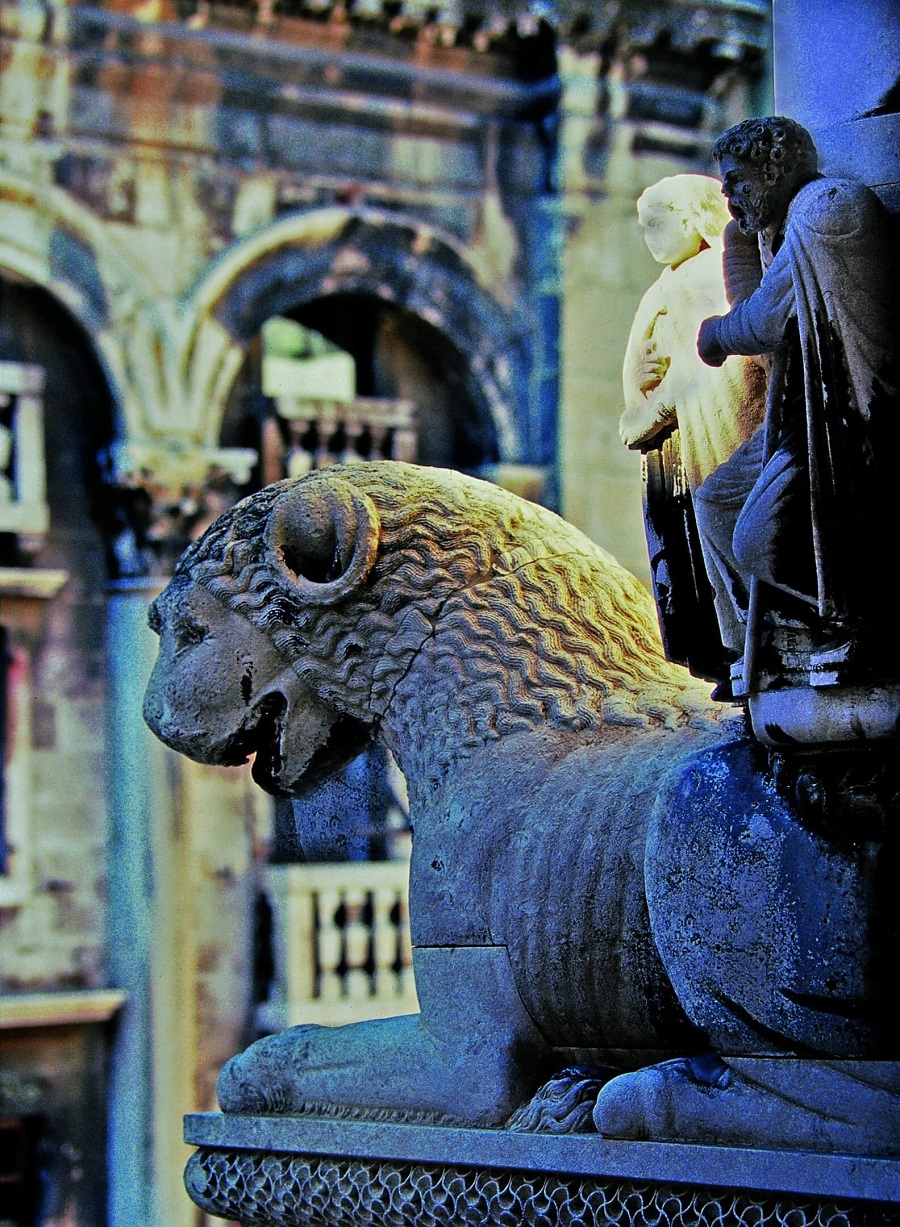
Peristyle is the location for the best-preserved sphinx till today, and there is an assumption there were several sphinxes in front of the temples and mausoleum. All sphinxes date back to the time of Pharaoh Tutmosis III, and there were probably 11 or 12 sphinxes. The Peristyle sphinx is old 3500 years, and it made from black granite. Its paws don't end with ion claws but with human hands holding the sacrificial vase. Medieval people called it Gorgona and were superstitious and avoided any eye contact with this pagan symbol. It is 2,46 meters long, 1m high 0.65 m wide. It was probably one of the four sphinxes guarding the entrance to the mausoleum. The beheaded sphinx in front of Jupiter's temple is also from these times, and it got destroyed as other sphinxes during early Christian times as it symbolised the fight against Christianity. There is one smaller sphinx in the palace substructure and City museum Split. There is one sphinx head on the house in Dominis street. Other fragments are in the Archaeological Museum, City museum Split and Diocletian's basements. Some sphinxes are cut in half, and some are without the head or have destroyed paws and faces. The sphinxes represented the divinity of the emperor, who was also the Egyptian pharaoh.
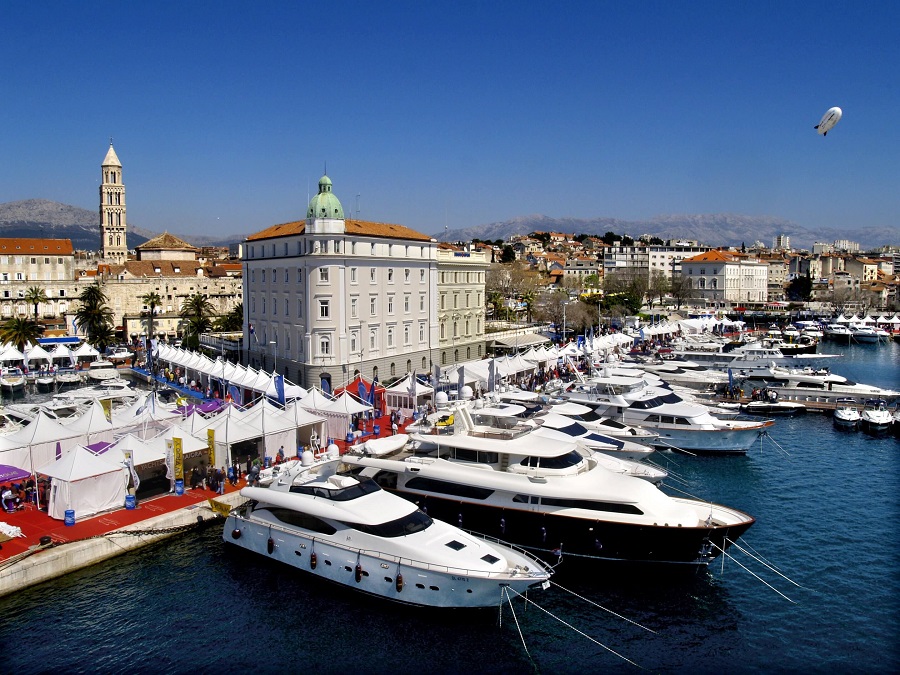
The Vestibule is the hall that connected the Emperors' apartment and Peristyle. The Vestibule is a lobby area before entering the Diocletian's apartment. In four niches, there were probably sculptures of Tetrarchs while today there aren't any. The outer part of this room has a square shape while from inside it is circular – before it had a dome with a mosaic. As this is an acoustic hall, it's today a spot for local klapa signers to entertain tourists and locals.
The mausoleum building became the Split Cathedral, and it is the oldest building in use as a cathedral. The cathedral interior has a mixture of ancient pagan, Christian Medieval, and modern heritage. Mausoleum of the Emperor - the persecutor of Christians, became a cathedral in the 7th century and had altars with relics of St Domnius and St Anastasius, martyrs executed in the nearby Solin. The first bishop of Split Ivan Ravenjanin consecrated the Cathedral to Assumption of Virgin Mary and martyrs St Domnius, St Anastasius, St Kuzma, and St Damjan. It is locally known as the Cathedral of St Dominus, who is a patron saint, and it's celebrated every year on May 7th. The Cathedral is in the central part of Diocletian' Palace, and it is the oldest building in the world in use as a cathedral. The building has an octagonal shape and has covered periptery with 24 marble columns with Corinthian capitals. The portal of the Cathedral was also from ancient times. On the baroque stone board, there is the metropolitan and prime status of the church which archdiocese had until papal bull Locum Beati Petri in 1828. On top of the portal, there is a small sarcophagus - this is the burial site for remains of Katarina and Margarita, the daughters of Bela, the IV who died at Klis in the 13th century. The Cathedral is known for its wooden doors made by local master Andrija Buvina in 1214. The doors have 28 images presenting stories from Christ's life. These doors represented a rare example of well-preserved wooden doors.
The outer octagon of the mausoleum has an aisle (periptery) formed of 24 columns. The Cathedral is from the inside a round shape and is vaulted with a dome with a rectangle and semi-circular niches, which were in ancient times for statues of gods and emperors. The central place in the mausoleum was for Diocletian's sarcophagus, which got destroyed. The inside space is decorated with eight granite columns set on a base of white stone with Corinthian capitals. Above the decorated capitals, there is a wreath with the base for the second row of porphyry columns. Above other capitals, there is smaller wreath and frizz with an image of genius, Mercure Psyhopompos. There are medallions with images of emperor Diocletian and his wife, Prisca. After entering the Cathedral, on the left, there is a six-angle pulpit from the 13th century – it is elevated with six marble columns with capitals from local stone. There are four altars in the Cathedral. The right altar is consecrated to St Domnius, the patron saint, bishop of Salona, and martyr– the author of the altar is Bonino da Milano, and it is from the 15th century designed in late Gothic style. It is the oldest altar in the Cathedral. The left altar, consecrated to city co-patron St Anastasius of Aquileia is the work of Juraj Dalmatinac, who made it in the 15th century – it is made in the shape of the sarcophagus and has realistic relief depicting the Flagellation of Christ. There is a newer altar from the 17th century and another one from the 18th century. The new altar is held by two female statues, symbols of faith and persistence. There are images of angels symbolising victory, and above the altar, there are paintings with images from the Virgin Mary's life. The saints' relics lay in this altar.
The Cathedral has baroque wooden chairs carved in the 13th century and has different images of animals, plants, and geometrical shapes. Between the two-story arcades in the upper part of the seatbacks are depictions of the evangelists and apostles, and on the four ends of the seatbacks, the medieval city patrons of St Dujam and St Anastasius and St. Kuzma and Damian. Particularly impressive is the portrayal of the four priests singing from the open-hearted counter on the counter, which could be explained by a medieval method of "conducting": the rhythm was measured by the heartbeat of the chorister who held his wrist.
The east part of the mausoleum was demolished to expand the Cathedral. The choir was rebuilt in the 17th century. The cathedral treasury is the oldest in Croatia. One of the most important heritage of treasury is the Gospel of St Domnius – the oldest manuscript written on parchment paper preserved in Croatia. Additionally – there are other medieval codex's, matriculas, relevant archive documents, gold pieces, manuscripts like the manuscript of Toma archdeacon Historia Salonitana from the 13th century. St Lucy's crypt is below the cathedral level. There is also a water source, and tradition is to take this water on every St Lucy holiday.
The bell tower construction began in the 13th century and lasted till the mid-16th century. The construction material used was found in Salona. Due to the long period of building, it is a combination of Romanesque and Gothic Style. The tower is a unique architectural work, and it's special due to its slenderness and transparency and its incorporation in the ancient architectural environment. With the use of wreaths and capitals, the tower fits in Peristyle square and its arches and columns. In the 19th century, the restoration process started and lasted until the beginning of the 20th century. The top floor with renaissance elements was changed entirely. Numerous antique spoliae and sculptures of griffin, lions, sphinxes, and people were removed. Some fragments of the old bell tower are in City museum Split or are built-in Tusculum building in Salona. Initially, the tower was 53 m high, and today is 57 m high. You can climb the steps to the top of the bell tower and have a spectacular view of the entire Split.
With the construction of a new city square with the town hall (Pjaca) in the 13th/14th century, Peristyle became a religious centre with the Cathedral as the primary place for liturgy with millennium-long tradition. Today it the central area of Split and location where you can enjoy so many different centuries in history and art. As the heart of the Palace, it has two main streets crossing there lead to the palace entrances. The entrances are the Brass gate on the south, Iron gate on the west, Silver gate in the east, Golden gate on the north – the main palace entrance. These names originate from the 16th century and before they were named based on the side of the world. All three land entrances have a double gating system.
The Brass Gate or in Roman Porta Meridionalis is different from all the other entrances – it was modest in size, and it led to palace Substructures from the seaside. They were considered as secure gates as it ensured one could escape the Palace on the shore in case of attack.
Today they are the busiest gate in the place as its often a starting point for numerous tours. There was a small St Anastasius church built in the 9th century, and it was used until the beginning of the 19th-century after it became a residential house.
The Iron Gate or in Roman Porta Occidentalis is the entrance that was always in use throughout the centuries. The entrance was called free doors or Porta Franche in medieval times as they were only doors that didn't close after the city developed to the west. In that time, "inter ambas portas" or in between double gates was the place for the public courthouse, and it was an asylum for outlaws. As the pavement is higher now, these doors lost their original shape. The west gate had eight angle towers, the same as the Golden and Silver gate. The guards' corridors above the palace gates were transformed into a church in the 6th century. The passage above the Iron gates is consecrated to St Theodor church and the later church of Our Lady of Bell tower with the oldest preserved Romanesque bell tower. The Christianisation of the Palace can be seen at the Iron Gate in the relief of Nika, Roman goddess of Victory, which was reshaped in early Christian cross. Right next to the gate, there is a tower with the 24-digit clock. Today here we have several shops.
The Silver gate, or in Roman the Porta Orientalis, were used to enter the Palace from the east. This entrance was more modest in decorations than the Golden Gate, and it was closed in Medieval times till 1952 and then were reconstructed after Baroque church Dušica was demolished. In the 6th century, the church of St Apolinar was built, and it got destroyed beginning of the 17th century – there aren't any material remains found only on sketches from the 17th century. There are visible remains of the octagonal towers, and now is the place for different open door shops and are closest to Splits' famous Green market.
Golden Gate or in Roman Porta Septemtrionalis was built in the shape of a rectangle, with double doors, as part of the defensive military strategy (propugnaculum). The Golden Gate was the main entrance to the Palace with lavish decorations. In the niches, there were probably figure sculptures of the four tetrarchs (Diocletian, Maximian, Galerius, and Constantius Chlorus), and in the middle was eagle as a symbol of god Jupiter. These doors, starting from Peristyle, and then through Cardo street, led directly towards Salona as the capital city of the Roman Province Dalmatia, and could only be used by the emperor and the members of his family. These gates were closed during medieval times. As part of the Golden gate, there is the church of St Martin, probably built in the 6th century. The St Martin church changed several times, and today, it is restored to the original look with pre-Romanesque marble altar partition from the 11th century, which is in the same place. St Martin is the smallest church in Split and an excellent example of preserved church interior and site for the female Dominican monastery. Today the Golden Gate is one of the best-known spots in Split.
The North facade of Diocletian' Palace and its north wall is 170 m long and has Golden gate in the middle and square tower on each end. From all previous eight angle towers, there are remains. The walls here are simpler, and this was the main entrance to the Cathedral. There were several other objects built around the golden gate – like St Euphemia church, the Benedictine monastery of St Mary, later on, military hospital, from which there is St Arnir cathedral, tower, and the remains of floor plan.
The statue of Gregory of Nin is one of the best-known sights in Split. He was a historical figure who fought in the 10th century for liturgy in the local language – Croatian and the use of Glagolitic letters. The pope abolished the Nin diocese, and the official language of the liturgy was Latin, which was supported by the Split archdiocese, but they still served masses in old Slavic language as a lot of priests didn't know Latin. Famous Croatian sculptor Ivan Meštrović built the statue - the statue was originally in front of the Cathedral. During the second world war, Italian occupiers had it removed and cut in pieces. During the 50ies of the 20th century is restored and places on its current location – this well-known lucky charm of Split – everyone should rub its golden toe for good luck.
On the side of the west wall of the Palace, there is Bosanska street now place for numerous souvenirs shops and shops originally. The top of Bosanska street was the main entrance to the old city. The street got its name after a lot of Bosnian merchants who were there during the 17th and 18th centuries. From there, you can turn to the so-called Jewish passage and go to a Split synagogue built in the 16th century, which makes it the third oldest synagogue in Europe.
Pjaca or Narodni trg is the place you will reach at the end of Bosnian street. This square was previously St Lawrence cemetery, and it became a municipal centre in the 14th and 15th centuries when the communal building was built in the style of Venetian gothic – it included the duke's palace, jail, communal palace, and city loggia which later became the city hall. Old city hall is only preserved building from the late gothic range of building from the 15th century, which was torn down in the 19th century. It has an original appearance on the ground floor. The city hall was connected with Karepić palace and St Lawrence church used by the duke. On the east side of the square is the Iron gate and already mentioned city clock with 24 digits as well as the beautiful Palace Cipriani Benedetti decorated with two six arched windows and statue of St. Anthony the Hermit. On the south side there is the renaissance palace Pavlović and on the west, there is the art deco house Nakić. Pjaca square has always been the centre of city municipality and centre of everyday life, and it still is.
Voćni trg or fruit square is located south from the Pjaca – on the south. There is a Venetian tower from the 15th century built as accommodation for Venetian crew and defence. On the north, there is the baroque palace Milesi from the 18th century and on the square central position is for the statue of Marko Marulić – the father of Croatian literature, again work by Ivan Meštrović. The square was the space for fruit trade till the mid-20th century, and that's why it's called fruit square.
There are numerous small churches and chapels scattered around the city – some are demolished during the time, and for some, we can find remains – the article already mentioned several churches in the old town centre. Also, Split was fortified during the 17th century and had five baroque fortifications called Cornaro, Corner, Priuli, Bernardi, and Contarini connected with walls. Some parts of fortifications were used during French rule for decoration Riva promenade and Marmont street.
The City museum of Split, which keeps a lot of valuable heritage, is located in Papalić palace. This Gothic-Renaissance palace made by Juraj Dalmatinac is the home for ancient stone monuments since the end of the 15th and beginning of the 16th century. The family Papalić had a collection of ancient stone monuments from Salona. Dmine Papalić and Marko Marulić (born in the same street as the Papalić palace) were researching findings in Salona and brought ancient inscriptions to the courtyard of the palace. The city museum opened in 1946, and the first director was Marko Uvodić, who is author of numerous stories and chronicler of life in Split. The museum has several different collections, and it is a good starting point to discover the centuries-long history of Split.
Over the centuries, the palace inhabitants and later the citizens of Split adapted parts of the Palace for their requirements. The interior of the Palace, as well as the exterior walls, changed throughout the centuries. Even with all the changes, the outlines of the Palace are still visible. Split changed a lot with different cultures living there and sharing their ways of living and building. Today we have all this heritage as proof of centuries-long life in the city.
SOURCE (text and photos): UNESCO, Visit Split – Split Tourist Board, City museum Split
Sudamja 2020: Split Celebrates City Day and Sv. Duje
May 7, 2020 - The City of Split traditionally celebrates its patron saint, Sv. Duje, on May 7.
Split City Day is here, when the citizens honor and celebrate Split’s protector - Sv. Duje.
But who is Sv. Duje, anyway?
Also known as Saint Domnius, Saint Dujam, Saint Duje, Saint Domnio, Saint Doimus, or Saint Domninus, our Sv. Duje was born in today's Syria and was an early Christian bishop of the Roman city of Salona, the capital of the Roman province Dalmatia. Emperor Diocletian ordered Duje’s arrest in AD304, and he was executed along with other martyrs in Salona's amphitheater. Buried outside of the city walls, his grave became a place of worship.
While one might find it ironic that our Duje is the protector of the town founded by the emperor who executed him, it is perhaps even more peculiar that Emperor Diocletian’s mausoleum was converted into the Sv. Duje Cathedral, which is regarded as the oldest Catholic cathedral in the world that remains in use in its original structure.
The Sv. Duje Cathedral stands proud in the heart of the Old Town, and it only makes sense that the City Day celebrations begin here, where the Croatian flag is raised on top of the cathedral's bell tower.
Religious or not, this act highlights the bond Split citizens share with Sv. Duje, as it represents an identification with the city's heritage.
Split’s City Day celebration is usually a grand affair named ‘Sudamja’, which gathers thousands of Split citizens in the city center on May 7. From fairs to concerts, fireworks to bingo, folklore dances to exhibitions and regattas - Sv. Duje is the celebration of all celebrations in this ancient Croatian city.
However, the highlight is the centuries-old procession, held on the morning of May 7. While Sv. Duje’s relics were once carried around the entire old town, today, the procession begins at Peristyle in front of the Cathedral and continues to the Riva, where Holy Mass is held.
This year, however, as the world is rattled by the corona crisis, a more modest Sv. Duje celebration awaits. While no gatherings of large groups are allowed, and we are still adhering to strict measures by the National Civil Protection Headquarters, this year, Sudamja is coming to our homes.
"The traditional festival on the occasion of the feast of Sv. Duje has for years awakened in us a spirit of togetherness and belonging. Guided by the message of the #TogetherInSplit campaign, together, many got involved in creating projects to give their fellow citizens a different celebration of City Day.
At 10 am on HRT, you can follow the Holy Mass from the Sv. Duje Cathedral, and in the afternoon, at 6:20 pm, enjoy the recording of the Petar Grašo concert in the empty Peristyle, which brings a touch of optimism, light and celebration, organized by the City of Split, the Split Tourist Board with partners Dalmatian Concert and OTP Bank.
The Sv. Duje balcony party has been organized by Fabrique pub with partners Apodos agency, photo studio Smile and the Split Tourist Board. From 5 pm to 8 pm, the moving stage will tour the neighborhoods of Split where Marko Pecotić Peco and his band will sing Dalmatian hits. Go out to your windows and balconies and send a video message of unity to the world on our City Day.
The Split City Museum, Croatian National Theater Split, KUD Jedinstvo, Music Youth of Split, Ethnographic Museum, Center for Culture and Lifelong Education Zlatna Vrata, Collegium Split through history and many others have also joined in on the virtual fun, and dedicated their publications to the importance of tradition to preserve the unity and identity of one city," says the Split Tourist Board.
For more information, visit the Facebook pages of the City of Split and the Split Tourist Board.
Happy Sv. Duje to all!
To read more about lifestyle in Croatia, follow TCN's dedicated page.
Sudamja at Home: TZ Split and Fabrique Hosting Sv. Duje Balcony Party
May 5, 2020 - As part of the #TogetherInSplit campaign, the Split Tourist Board and Fabrique Pub are bringing a touch of the Sv. Duje tradition to your homes on May 7.
Namley, a mobile stage will be touring the Split neighborhoods where Marko Pecotic Peco and his band will sing Dalmatian hits. The Split Tourist Board wants all citizens at their windows and on their balconies to send a video message of community on Split's City Day.
"The traditional Sv. Duje feast has, for many years, awakened Split citizens in a spirit of community and belonging. Even though we are physically separated, this will be a unique postcard from Split on the day of the Sudamja celebration during the pandemic, so let's all go out to our windows, balconies and show that we are a small city with a big heart. After our collective postcard, enjoy the unique concert of Peter Graso in an empty Peristyle," said the director of the Split Tourist Board, Alijana Vukšić.
"Guided by the message of the #TogetherInSplit campaign, we wanted to thank our guests and fellow citizens for their many years of support and all the moments of fun and friendship we spent at the Fabrique pub. We have gathered our co-workers and friends, and we thank them for their engagement and for showing us that we are truly together during these difficult times. Special thanks to Marko Pecotic Peco and his band, the Apodos company for providing the panoramic bus, photographer and cameraman Ranko Pupic from Studio Smile and his valuable crew who will record reactions from your balconies, and the Split Tourist Board," said Fabrique pub.
The mobile stage will depart at 6 pm from the taxi stand near the Tourist Palace on the Riva. You can find the locations on the route below:
Bačvice- Firule taxi stand- Križine bus station - Mertojak (Elekrodalmacija)- Kila- Pujanke- Kampus- Vukovarska- Kacunar- Kman- Brda- Dubrovačka- Kazalište – Skalice- Stari plac- Krom- Lazarica- Poljud- Sv. Frane.
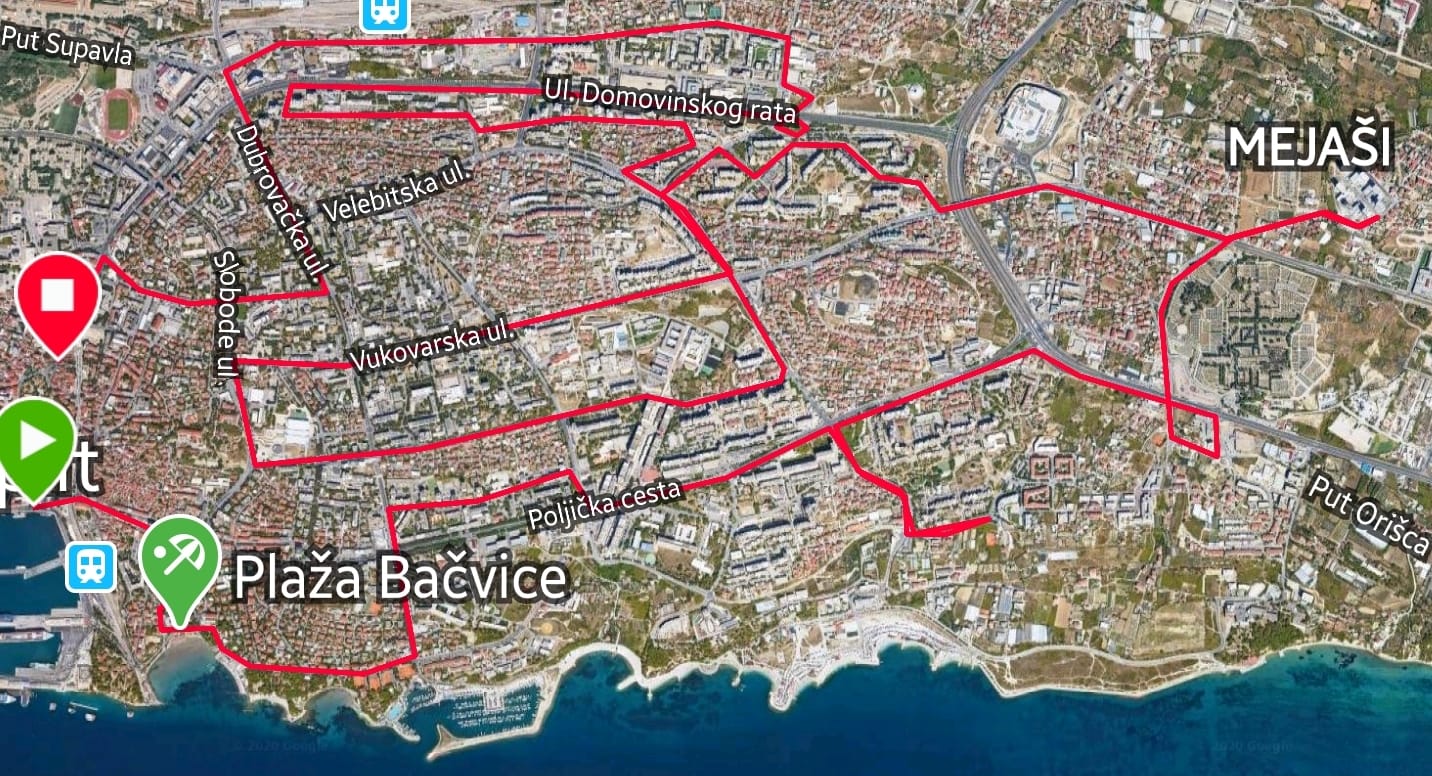
To read more about lifestyle in Croatia, follow TCN's dedicated page.
Split Ambasador Hotel Opening Delayed by Corona: "We'll Open Before Christmas"
May 4, 2020 - The opening of several hotels in Split was announced for the upcoming tourist season, including the Ambasador on the West Coast Riva.
Slobodna Dalmacija writes that Tonci Medic, CEO of Retoi, whose portfolio also includes Ambasador, and a close friend of German businessman Klaus Alex Birkenstock, owner of this hotel, assures us that, given the coronavirus crisis, they won’t be able to open their doors to guests until Christmas.
“The corona crisis has definitely surprised us all. In March, we started collecting CVs and organizing interviews with potential employees, but of course, we had to stop. The plan, in fact, was to ‘permanently’ hire 55 staff and hire another thirty seasonal workers. Since we were planning to open the hotel doors this summer, we hired six people key to its operation earlier this year; among them the director and the chef.
This has completely hindered us - outside construction work has been suspended at the request of the contractor, that is, workers' fear of contracting the virus. As for the works inside the building, we thought it was pointless to rush to finish them when we had to keep the hotel closed.
We simply estimated that we did not want to risk anything and that it is better to skip this season, if there is one at all, than to begin during a pandemic and fear whether any of the staff or guests will transmit the virus to our hotel,” says Medic, a well-known caterer from Brela.
Recall, Klaus Alex Birkenstock bought the hotel on the West Coast in 2016 from Regina Ivic, the widow of Tomislav Ivic, the legendary Hajduk coach. It was announced that the Ambasador would be open in the spring of 2018, but the investor could not meet the deadline due to the inability to obtain a building permit.
For this reason, the demolition was delayed of the building built in 1937, which was later the JNA House, as was the execution of the works. The investor was forced to ask the County to extend the construction period from two to four years.
In the meantime, there was a change in investment from the previously announced EUR 14 million to EUR 23 million. This should give the Ambassador at least four and a half stars, and they hope, Medic says, to get a fifth.
According to the project of architects Nena Kezic, Emil Sverk and Nora Roje, the hotel will have 101 rooms and suites, a restaurant capacity of 240, spa, gym, nightclub and underground garage with 59 spaces. Otherwise, the hotel's catering facilities will be able to accommodate 640 guests, in addition to the 240 in the restaurant.
The fitness and wellness center will be sunlit thanks to a large atrium on the terrace facing the sea. It is also interesting that in the superstructure of the movie theater, which was erected next to the “Ambasador” in 1953, there will be a 120 square meter large swimming pool, which will be partially enclosed by glass, so that passers-by will be able to look in. Swimmers, on the other hand, have a view of the coast.
In any case, Birkenstock has announced that it plans to turn this Split hotel into a new favorite resort for tourists from the UK, Germany, Austria and France. Unfortunately, the plan is currently on hold, but hopefully not for long.
To read more about travel in Croatia, follow TCN's dedicated page.

